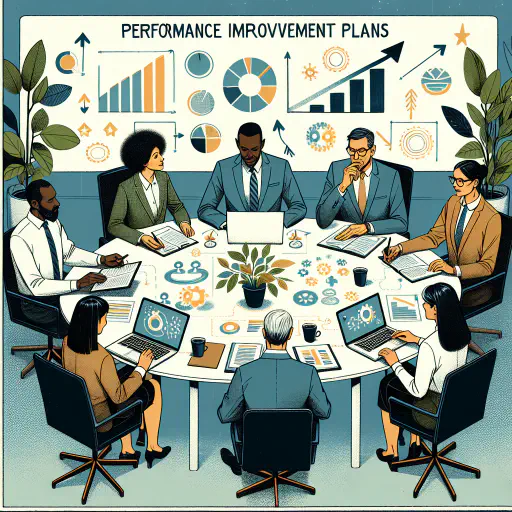
Performance Improvement Plans: How to Turn Underperformers into Star Employees
Welcome to a guide where you’ll find practical methods to elevate the performance of team members lagging behind. Learn to craft an environment that encourages excellence, merging individual advancement with your company’s aspirations.
Struggling to enhance the performance of an employee can be daunting. When team members fail to meet expectations, the repercussions are felt: morale dips, productivity wanes, and the bottom line suffers. The causes vary, from vague objectives to mismatched roles. Addressing these issues is pivotal for converting underperformers into invaluable assets.
In this blog, we’ll explore effective strategies to achieve this goal. You’ll gain insights into fostering a culture that prizes development and drives corporate success.
1. Conducting Thorough Performance Evaluations
Conducting thorough performance evaluations is essential to identify an employee’s specific struggles and to set realistic and targeted goals for improvement. Quantitative data such as sales figures, project completion rates, and qualitative feedback from various sources should be gathered and analyzed. Direct observation of work habits and interactions provides additional insights. These evaluations serve as the foundation for a customized performance improvement strategy.
Gathering Quantitative and Qualitative Data
In the quest to elevate employee performance, the power of data is undeniable. Quantitative metrics like sales numbers or project deadlines, enriched with qualitative insights from peers and supervisors, paint a comprehensive picture of where an employee stands.
A quick anecdote: A sales associate’s numbers were slipping, but it wasn’t until we gathered feedback that we discovered the issue was a lack of product knowledge, not effort. This revelation guided our targeted training approach.
Direct Observation for In-Depth Insights
Sometimes, the most telling details come from simply watching someone in action. Observing an employee’s day-to-day interactions and work habits can reveal hidden strengths and areas for improvement.
Case in point: observing a customer service rep in action revealed that their soft skills turned challenging calls into positive outcomes, an area we could then leverage and develop further.
Analyzing Data to Identify Specific Issues
Dive into the data with a detective’s keen eye, looking for clues that reveal the true nature of performance issues. Just like a medical diagnosis, pinpointing the precise challenge is half the cure.
For instance, if project completion rates are low, is it due to time management, or is there a lack of necessary skills? The answer will shape a more effective improvement plan.
Customizing Improvement Strategies
Each employee is as unique as a fingerprint, and so should be their improvement plan. By personalizing strategies, we acknowledge their individuality and set them up for real, achievable progress.
Take John, a diligent but disorganized project manager. With a tailored plan focusing on time-management techniques, we turned his chaotic process into a streamlined success.
2. Establishing Clear Expectations and Objectives
To turn underperformers into star employees, it’s crucial to set clear expectations and objectives. This provides them with a transparent roadmap to success. Goals should be specific, measurable, achievable, relevant, and time-bound, adhering to the SMART framework. This strategic approach clarifies the path forward and enables both the employee and manager to effectively track improvements.
Clarity in Role Expectations
Employers should use job descriptions and performance standards as tools to communicate the tasks and behaviors expected of employees. Providing a clear understanding of their role eliminates confusion and helps employees focus on meeting those expectations.
Specificity in Goals
Setting specific goals ensures that employees understand exactly what is expected of them. For instance, instead of a vague directive to “improve sales,” a specific goal would be “increase sales by 10% within the next quarter.” This level of precision allows employees to concentrate their efforts and measure their success.
Measurability for Progress Tracking
Goals need to be quantifiable, allowing for regular check-ins on progress. If the goal is to increase customer satisfaction, then measuring this through surveys or feedback forms can provide tangible indicators of improvement or areas that require more attention.
Achievability to Ensure Success
While goals should present a challenge, they must also be within reach. Unrealistic goals can lead to employee demotivation and overwhelm. For example, offering additional training to achieve a new certification within a reasonable timeframe respects the employee’s capabilities and other work responsibilities.
Relevance to Personal and Company Growth
Goals must align with both the company’s objectives and the employee’s career aspirations. This ensures that the individual’s skill set and the company’s innovation efforts both benefit. For instance, a software developer could be encouraged to learn a new programming language that is becoming vital in the industry.
Time-Bound to Create Urgency
Setting a deadline for goals, such as mastering a new CRM system within three months, instills a sense of urgency and compels employees to prioritize their goals. This gives them a clear timeframe for their learning and application of the new skills.
3. Creating a Tailored Improvement Plan
A personalized improvement plan is vital, as it acknowledges the unique strengths and challenges of each employee. Engaging the employee in the plan’s development is crucial to ensure their commitment. By creating specific steps for skill and behavior enhancement that cater to their individual needs, the plan sets a foundation for success.
The plan should be dynamic, allowing for adjustments as the employee grows and progresses. This personalized strategy is far more likely to result in genuine and lasting performance improvements, as it adapts to the evolving landscape of the employee’s abilities and contributions.
Involvement and Buy-in
Securing employee buy-in is essential for the success of any performance plan. Involvement from the beginning allows the employee to voice their concerns and preferences. By holding collaborative meetings where the employee and manager discuss potential steps and goals together, you create a shared vision for improvement. It’s akin to a partnership; when the employee feels they are part of the process, they are more committed to the outcome.
Personalized Steps
A one-size-fits-all approach is ineffective for personal development. Identifying the employee’s unique needs and tailoring the improvement steps accordingly ensures that each step directly contributes to overcoming their specific hurdles. For example, if an employee struggles with time management, introducing them to specific tools or techniques to better track and allocate time can make a significant difference.
Dynamic Plan
The flexibility of the improvement plan is key. As the employee progresses, their needs will change, necessitating that the plan adapts alongside them. Regular reviews and revisions of the plan are essential to ensure it remains relevant and continues to provide the right level of challenge and support. Think of it as a personalized training program that evolves, reflecting the growth and development of the employee.
4. Offering Constructive Feedback and Guidance
Offering constructive feedback and guidance is essential in transforming underperformers into star employees. It’s about striking a delicate balance between providing encouragement and presenting actionable advice. Regular, timely feedback is crucial, and it should focus on specific behaviors or outcomes rather than on general comments.
Regular Feedback Sessions
Holding regular feedback sessions helps keep the employee on track and makes them feel supported. An anecdote about a salesperson who improved dramatically after weekly sales strategy meetings can illustrate the power of consistent feedback. This practice shows the employee exactly where they stand and what adjustments are necessary.
Specific and Actionable Advice
When providing feedback, it’s vital to be specific and actionable. Instead of telling an employee to “be more proactive,” guide them with clear steps like “initiate weekly check-ins with team members to anticipate project needs.” This specificity helps employees understand and apply feedback effectively.
Strengths-Based Approach
A strengths-based approach encourages employees by leveraging their natural abilities. Recognizing and utilizing an employee’s strengths can be as impactful as addressing their weaknesses. A case study of an employee who excelled after being moved to a role that matched their strengths can serve as an illustrative example of this strategy.
Constructive Criticism Techniques
Techniques for delivering constructive criticism should focus on improvement and growth. Using the “sandwich” method, where criticism is nestled between compliments, can make feedback more palatable. This method ensures that employees receive guidance in a way that is encouraging and not demoralizing.
Encourage Self-Assessment
Encouraging employees to self-assess their performance fosters self-awareness and responsibility. By reflecting on their own work, employees can often identify areas for improvement and feel more invested in the process of their performance enhancement.
Use of Clear Examples
Using clear examples when providing feedback helps employees understand the practical application of advice. Sharing stories of how similar feedback has helped others improve provides a relatable model for employees to follow, adding a layer of credibility and inspiration to the guidance given.
Continuous Learning Opportunities
Linking feedback to continuous learning opportunities allows employees to actively work on their areas of improvement. For example, if an employee needs to improve their technical skills, recommend specific online courses or in-house training. This shows them a clear path to improvement and demonstrates the company’s investment in their growth.
Positive Reinforcement
Positive reinforcement encourages employees and bolsters their confidence. Celebrating small wins and improvements can motivate employees to continue their efforts. Sharing testimonials from customers or peers about the employee’s progress can provide tangible proof of their advancement and the positive impact of their efforts.
5. Fostering a Culture of Continuous Learning
To transform underperformers into star employees, fostering a culture of continuous learning is crucial. Encourage the pursuit of growth by providing access to training and development opportunities. These should align with both career aspirations and organizational goals. By investing in professional development, you not only enhance their abilities but also contribute to the company’s success.
Training Sessions and Workshops
Offering training sessions and workshops is a direct method to support continuous learning. An employee struggling with presentation skills, for example, might benefit from a workshop on public speaking. By providing practical, hands-on learning experiences, employees can quickly apply new skills to their work. This leads to immediate benefits to their performance.
Mentorship Programs
Mentorship provides personalized guidance and offers learning opportunities from experienced colleagues. Sharing a story of a successful mentor-mentee relationship within the company can be incredibly motivating. Such relationships can accelerate learning and growth, giving underperformers a clear example of the path to excellence.
Aligning with Career Aspirations
It’s important to align learning opportunities with the employee’s career goals. A testimonial from an employee who has advanced in their career due to targeted training can illustrate this point. This alignment ensures that the employee remains motivated and engaged in their development journey.
Encouraging Self-directed Learning
Encourage employees to take ownership of their learning by seeking out resources and courses that interest them. Highlighting case studies of self-directed learners who achieved success can inspire others. This initiative not only improves their current performance but also prepares them for future roles.
6. Enhancing Communication Channels
To cultivate a successful performance improvement initiative, it is crucial to provide employees with opportunities to voice their concerns and share their achievements. Regular check-ins foster an open dialogue, while also allowing for adjustments to improvement plans based on employee input and collaborative effort. This ensures that communication remains a two-way street, which is essential for the plan’s success.
Regular Check-Ins
Regularly scheduled meetings between managers and employees are essential for tracking progress and addressing concerns. During these sessions, employees should feel comfortable discussing their challenges and achievements.
An effective technique is to incorporate a “start, stop, continue” framework, where employees can reflect on what they should start doing to improve, what isn’t working and needs to stop, and what successful actions they should continue. This approach not only creates a structure for the conversation but also empowers employees to take charge of their own development.
Active Listening
Managers must practice active listening, which involves fully concentrating on what is being said rather than just passively hearing the message of the speaker. When employees feel heard, they are more likely to engage in the improvement process actively.
This can be demonstrated through verbal affirmations, summarizing their points for clarity, and asking open-ended questions to delve deeper into their perspectives.
Bidirectional Feedback
Creating a space where both the employee and the manager can give and receive feedback is valuable. It’s important to have a balance where employees can express their views on the support they need while also receiving constructive feedback on their performance.
Encouraging this bidirectional feedback can lead to more effective improvement strategies and a greater sense of agency for the employee.
Transparency in Communication
Maintaining transparency about the goals, expectations, and potential outcomes of the performance improvement plan is vital. This clarity helps to align the employee’s efforts with the organization’s objectives and can reduce anxiety or confusion about the process.
By being open about the criteria for success and the consequences of not meeting expectations, employees are better able to understand and commit to their improvement journey.
Collaborative Goal Setting
Involving employees in setting their own goals can significantly increase their engagement and commitment to improvement. This collaborative goal setting should focus on achievable, clear targets that the employee feels are valuable and relevant to their growth.
When employees have a say in their own objectives, it fosters a sense of ownership and motivation towards achieving them.
7. Leveraging Strengths and Addressing Weaknesses
To transform underperformers into star employees, it’s crucial to focus on leveraging their strengths while also addressing areas for improvement. Identifying what the employee does well and finding ways to incorporate those strengths into their daily responsibilities is the first step. At the same time, a supportive plan should be developed to improve upon their weaknesses, possibly through training or mentorship. This balanced approach promotes confidence and supports the employee’s growth, creating an environment where they can excel and contribute significantly to the team’s success.
Identifying Core Strengths
Everyone has areas where they excel, and it’s important to identify these in employees. For instance, someone might have excellent interpersonal skills but struggle with time management. By placing them in roles that leverage their natural affinity for communication, not only are you setting them up for success but also increasing their engagement and job satisfaction.
Personalized Training Programs
Tailored training programs can address specific weaknesses in an employee’s skill set. Suppose an employee is excellent at idea generation but poor in execution. Project management workshops could help bridge this gap, providing them with the tools they need to turn their creative ideas into successful projects.
Mentorship Opportunities
Pairing an underperformer with a mentor who excels in the employee’s areas of weakness can provide a role model and a source of one-on-one guidance. This mentorship can include shadowing opportunities, regular feedback sessions, and shared learning experiences that are invaluable for growth.
Celebrating Small Victories
Recognizing and rewarding improvements, even the small ones, can significantly boost morale and motivation. If an employee who has struggled with punctuality starts showing up on time consistently, acknowledging this change can reinforce positive behavior and encourage continued improvement.
Continuous Feedback and Adjustment
Providing ongoing feedback ensures that employees know how they are doing and what adjustments to make. It’s a dynamic process that may involve altering strategies or introducing new resources to help the employee overcome challenges and continue their growth journey.
8. Ensuring Accountability with Milestones
Ensuring accountability with milestones involves setting specific targets for employees, tracking their progress, and recognizing their achievements. It’s a method that helps maintain momentum and gives employees a clear sense of achievement as they work towards their goals.
Setting Specific Targets
To ensure employees know what’s expected of them, set specific, actionable targets. For example, if the goal is to improve sales, a target might be to increase sales by 10% over the next quarter. This clarity helps employees focus their efforts and provides a benchmark for success.
Tracking Progress
Regular monitoring of an employee’s progress towards set milestones is essential. This could be done through weekly or monthly check-ins and reviews, using tools like progress reports or dashboards that visually present data on key performance indicators.
Celebrating Successes
When employees hit their milestones, take the time to celebrate. This could be as simple as a congratulatory email, a mention in a team meeting, or a small reward. Recognizing efforts not only boosts morale but also reinforces the importance of the improvement journey.
Addressing Challenges
Challenges are inevitable, but they become learning opportunities when approached correctly. Discussing these hurdles in one-on-one meetings and brainstorming solutions together can provide employees with the support they need to overcome them and progress further.
9. Providing Necessary Resources and Support
To enable employees to excel and meet their performance goals, it’s crucial to provide them with the necessary resources and support. This involves assessing their needs and removing any obstacles that may hinder their progress. By facilitating access to the latest technology, flexible work arrangements, and a manageable workload, employees are empowered to focus on areas of improvement. This investment not only fosters employee growth but also benefits the organization as a whole.
Offering Advanced Tools and Technology
By providing state-of-the-art tools and technology, employees can streamline their workflows and increase efficiency. Tools such as project management software can help track tasks and deadlines, while CRM systems can improve customer relations. These resources demonstrate the company’s commitment to its employees’ success and aid in better performance.
Flexible Work Arrangements
Flexible work arrangements are known to boost productivity and morale. Options like telecommuting or flexible hours cater to different working styles and personal circumstances. Such a work environment shows that the organization values work-life balance.
Workload Management
Managing an employee’s workload is crucial for their focus and development. Prioritizing areas of improvement in an employee’s responsibilities can lead to more targeted and effective performance enhancement. This approach allows employees to fully engage with their development without being overwhelmed.
10. Monitoring Progress and Adjusting as Necessary
To ensure the success of a Performance Improvement Plan, it’s essential to continuously monitor the employee’s progress and remain flexible, making adjustments to the strategy as needed.
Regularly reviewing the individual’s achievements against their goals allows for timely interventions and the introduction of new methods if certain tactics are not yielding the desired results. This adaptive approach demonstrates the organization’s commitment to the employee’s growth and can help overcome unexpected challenges.
Scheduled Reviews and Check-Ins
Regularly scheduled reviews and check-ins provide structure and ongoing opportunities to gauge progress. A case study of XYZ company showed a 20% increase in underperforming employee turnaround when they implemented bi-weekly progress meetings.
Adapting the Improvement Plan
If an employee’s performance is not meeting expectations, be ready to adapt the plan. A testimonial from a manager at ABC Corp highlights how introducing new technology helped an underperforming sales team improve lead conversion rates by 15%.
Celebrating Milestones
Recognizing achievements, no matter how small, boosts morale and motivation. Personal reflections from employees at a startup revealed that celebrating weekly wins increased their drive and improved team cohesion.
11. Promoting a Supportive Team Environment
A supportive team environment is vital for individual and collective success, especially when implementing performance improvement plans. By fostering a culture of collaboration and mutual support, teams can significantly enhance the efficacy of these plans.
Actively encouraging team members to help and learn from one another can boost morale and effectiveness. When a team works cohesively, it not only aids an individual’s development but also fortifies the team’s overall dynamics and productivity.
Facilitate Team Collaboration
Team collaboration is the bedrock of a supportive environment. Initiatives like group brainstorming sessions or team-building activities can forge stronger bonds among members, making it easier for them to offer support.
For instance, a “think tank” session where team members collaboratively solve problems can illustrate the power of collective effort and encourage a culture of shared success.
Peer-to-Peer Learning Opportunities
Learning from colleagues can be incredibly effective. Setting up mentorship pairings or peer review systems can allow employees to share knowledge and skills in a comfortable setting.
For example, a seasoned employee could be paired with someone looking to improve, offering insights from their experiences that are directly relevant to the workplace.
Recognize and Celebrate Team Achievements
Acknowledging the team’s successes can propel a culture of support. Celebrating milestones reached by the team, not just individuals, encourages a sense of shared achievement.
An “Employee of the Month” award could be expanded to include “Team of the Month,” spotlighting the collective effort and success.
12. Recognizing and Rewarding Improvements
To boost morale and drive continuous performance improvement, it’s essential to acknowledge even the smallest progress made by employees. Celebrating these achievements affirms their value to the organization and motivates them to maintain and enhance their performance. Whether it’s through public recognition or private praise, tailored to suit the individual’s preferences, such acts of acknowledgment can inspire all team members towards excellence and foster a culture of growth.
Public Acknowledgment
Public recognition can have a powerful impact on employee motivation. Highlighting an employee’s success during a team meeting or featuring their story in a company newsletter not only boosts the individual’s morale but also sets a positive example for their colleagues.
Private Praise
For those who prefer a more personal approach to recognition, a manager’s private praise can be deeply meaningful. A thoughtful email or a one-on-one conversation shows that their efforts are noticed and valued on a personal level.
Tailored Rewards
Rewards should cater to what motivates an employee the most. Some might appreciate extra time off, while others could value professional development opportunities. By personalizing rewards, employers demonstrate an understanding of their staff’s unique preferences and needs. In conclusion, transforming underperformers into star employees takes commitment, patience, and a strategic approach. As you’ve learned, recognizing and rewarding improvements is a crucial part of this journey.
Now, I challenge you to take these insights and put them into action within your team. Start small – consider acknowledging a recent effort from an employee that might have gone unnoticed. Or, think about a tailored reward for someone who has shown progress.
Take the first step today and schedule a time to deliver this recognition. By doing so, you’re not only uplifting an individual, but you’re also contributing to a positive shift in your company’s culture.
Let’s turn potential into performance, one acknowledgment at a time.






